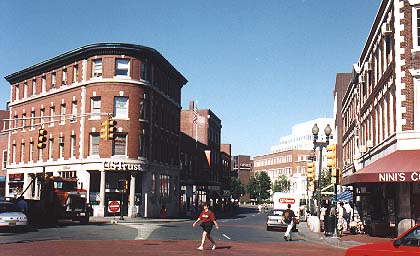Background Perspective on Downtowns
Downtowns are under stress. Retail businesses especially are suffering from changing retail patterns and shopping habits. Local residents are more mobile than in past decades. With more comfortable automobiles and convenient highways, residents no longer feel strong loyalty to local merchants and their businesses. They feel free to travel to the nearest shopping center or mall. In the 1960s, shopping centers began growing into serious competitors for downtown's customers. It is a competition that largely has been won by the ubiquitous shopping centers, malls, strip commercial areas and major discount centers.
 Given these changes, critical questions arise. What should be done about it? Should downtown businesses compete directly against major discounters and chain stores, such as Wal-Mart and The Gap, in an attempt to recapture their retail dominance? Should they evolve into new kinds of retail centers, with businesses that don't compete directly with the new chain stores, but are complementary to them? Should downtowns abandon their traditional retail role entirely and become service centers, relying increasingly on office and financial functions for their viability? Or are downtowns now obsolete, and should they be allowed to die a natural death, as have other elements of our 19th and early 20th century cities? The larger question underlying all these is--
Given these changes, critical questions arise. What should be done about it? Should downtown businesses compete directly against major discounters and chain stores, such as Wal-Mart and The Gap, in an attempt to recapture their retail dominance? Should they evolve into new kinds of retail centers, with businesses that don't compete directly with the new chain stores, but are complementary to them? Should downtowns abandon their traditional retail role entirely and become service centers, relying increasingly on office and financial functions for their viability? Or are downtowns now obsolete, and should they be allowed to die a natural death, as have other elements of our 19th and early 20th century cities? The larger question underlying all these is--
What is the role of downtowns in the coming century?
Various types of individuals (including downtown business owners and merchants, community leaders and city officials, and urban planners) need to better understand these issues, for downtowns still play a central role in our cities in a number of ways, including:
- Spatially, downtowns are at the center of urbanized areas, and thus exert an inherent locational centrality and focus.
- Downtowns represent the economic core of most urbanized regions.
- Downtowns have traditionally been the center of community activity, and still present the principal image of a city.
In many ways, healthy downtowns represent healthy communities.

 Given these changes, critical questions arise. What should be done about it? Should downtown businesses compete directly against major discounters and chain stores, such as Wal-Mart and The Gap, in an attempt to recapture their retail dominance? Should they evolve into new kinds of retail centers, with businesses that don't compete directly with the new chain stores, but are complementary to them? Should downtowns abandon their traditional retail role entirely and become service centers, relying increasingly on office and financial functions for their viability? Or are downtowns now obsolete, and should they be allowed to die a natural death, as have other elements of our 19th and early 20th century cities? The larger question underlying all these is--
Given these changes, critical questions arise. What should be done about it? Should downtown businesses compete directly against major discounters and chain stores, such as Wal-Mart and The Gap, in an attempt to recapture their retail dominance? Should they evolve into new kinds of retail centers, with businesses that don't compete directly with the new chain stores, but are complementary to them? Should downtowns abandon their traditional retail role entirely and become service centers, relying increasingly on office and financial functions for their viability? Or are downtowns now obsolete, and should they be allowed to die a natural death, as have other elements of our 19th and early 20th century cities? The larger question underlying all these is--
